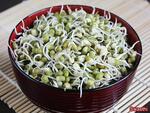
Mung Bean Sprouts, How to Sprout Mung Beans
Simple and easy steps to sprout mung beans or green gram at home. Sprouting beans at home is easy, hygienic & economical.
For best results follow my detailed step-by-step photo instructions and tips.
© Swasthi's Recipes - www.indianhealthyrecipes.com
Ingredients (1 cup = 240ml )
- ½ cup mung beans / green gram
- 2 cups water to soak
How to make the recipe
Preparation
- Add mung beans to a large bowl. First clean, pick and discard any stones or broken mung beans.
- Rinse them 3 to 4 times in lots of fresh clean water. While you do so rub the mung beans well and rinse. Discard the water completely.
- Pour fresh clean filter water and soak for at least 9 to 12 hours. I prefer to soak in dechlorinated or boiled and cooled water.
- If soaking for longer than 9 hours, discard and refill with fresh water. This prevents mung bean sprouts from developing an odor.
- When you are ready to sprout the mung beans, discard the water in which they were soaked. Rinse them at least 3 times with clean water. Drain to a colander.
How to Sprout Mung Beans
- Method 1 - Transfer the soaked & drained mung beans to a jar or bowl or a container. Ensure there is no water in them as we don't want them to develop a odor. Cover partially with a loose lid or with a muslin /cheese cloth.
- Method 2 - Rinse a cotton cheese or muslin cloth and wring it to remove excess water. Spread the cloth and transfer the drained mung beans to the center of the cloth.
- Bring all the edges together. Make a knot and tie it to a bundle (potli). Place this in a deep bowl. (Check pictures in the post)
- Transfer the bowl/ jar to a warm and dark place away from sunlight. Leave it undisturbed till they sprout. The time to sprout depends on the temperature. Some mung beans sprout within hours and some take as much as a day or two.
- After 12 hours check them if they have sprouted. If you prefer to grow them longer, sprinkle some clean water and let all of the excess water drain from the bundle or the jar/bowl. Any excess moisture left in the mung beans can rot them easily. Keep the bowl again in the same warm and dark place so they grow longer.
- Within 24 hours mung beans should sprout otherwise it means they are dead.
- Refrigerate the mung bean sprouts in a clean dry air tight jar and use with in 2 to 4 days. You can eat them raw or add to salads, soups, stir fry and curries.
NUTRITION (estimation only)
Calories: 32kcal | Carbohydrates: 6g | Protein: 3g | Fat: 1g | Saturated Fat: 1g | Sodium: 30mg | Potassium: 157mg | Fiber: 2g | Sugar: 4g | Vitamin A: 22IU | Vitamin C: 14mg | Calcium: 28mg | Iron: 1mg